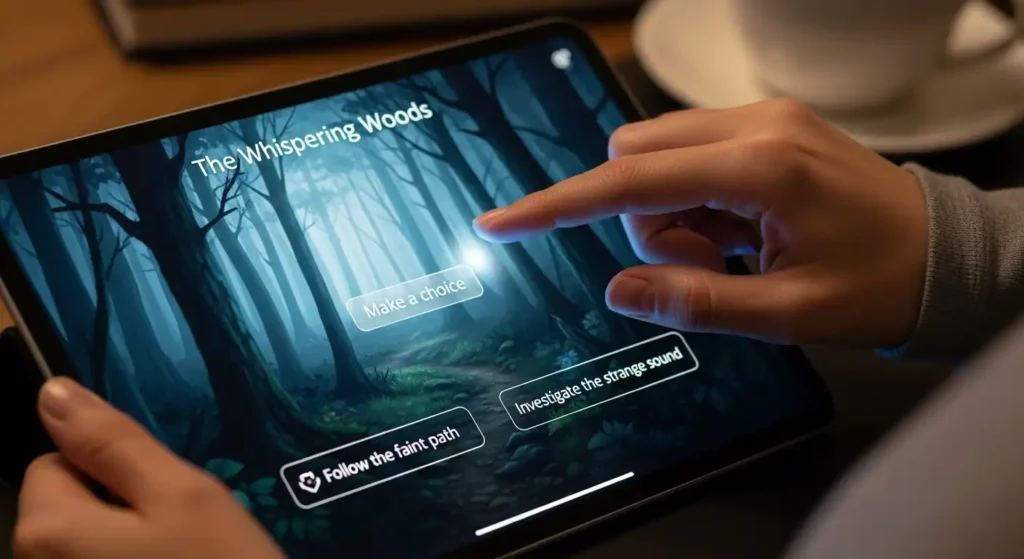Once upon a time, “choose your own adventure” books gave readers the thrill of making story decisions that shaped the ending. In 2025, that concept has evolved into interactive storytelling 2.0—an immersive experience blending literature, technology, and user participation. From digital story platforms to AI-driven plotlines, this new generation of interactive books is redefining how stories are created and consumed.
The Revival of Interactive Storytelling
Interactive books first boomed in the 1980s and 1990s, letting readers flip between different pages to follow alternative paths. The idea waned with digital media’s rise, but now, interactive fiction has made a massive comeback thanks to smartphones, apps, and online reading platforms.
Modern readers, especially younger audiences, crave participation and personalization. They don’t just want to read; they want to play a story. This fusion of gaming and literature has created what many call the Choose-Your-Own-Adventure 2.0 era.
What Makes Interactive Books 2.0 Different?

- Digital interfaces: Readers can now make choices through touchscreens, voice commands, or chat-style story apps.
- Adaptive storytelling: Some platforms use algorithms or AI to customize plotlines based on reader decisions or personality quizzes.
- Cross-media formats: Interactive stories often mix audio, illustrations, and animation to create a more cinematic reading experience.
This evolution blurs the line between novels, games, and streaming media. Platforms like Choices, Episode, and StoryLoom have already proven that readers are willing to pay for engaging, decision-based storytelling. Now, independent authors are bringing that magic into the book world, too.
Why Readers Love Interactive Stories
Interactive books allow readers to step into the story and feel like their decisions matter. That emotional connection creates a level of engagement traditional narratives rarely reach.
- Multiple outcomes: Each read can reveal new plot twists, encouraging replayability.
- Personal immersion: Choosing paths builds a personal relationship with the characters and outcomes.
- Community discussion: Fans share story routes online, comparing endings and discovering hidden paths together.
For many readers, interactive storytelling feels closer to gaming than reading—but still delivers the emotional depth and creativity of literature.
How Authors Can Create Interactive Stories
 Writing an interactive book is both a creative and technical challenge. Instead of a single linear narrative, authors must design a branching structure where every decision leads to different consequences. Here are some best practices:
Writing an interactive book is both a creative and technical challenge. Instead of a single linear narrative, authors must design a branching structure where every decision leads to different consequences. Here are some best practices:
- Plan the story as a tree, not a line. Each major decision should branch logically but still connect back to core themes.
- Keep choices meaningful. Avoid trivial decisions; readers should feel their input truly matters to the outcome.
- Use story-mapping tools. Software like Twine, Ink, or ChoiceScript helps visualize branches and manage complexity.
- Balance freedom and focus. Too many choices can overwhelm readers; keep it interactive, not chaotic.
- Playtest your story. Let beta readers try different paths and note where confusion or pacing issues occur.
Technology Driving the Trend
Advances in AI and natural-language processing have fueled new storytelling experiments. For example, platforms now allow readers to interact with AI-generated characters who respond dynamically to input, creating stories that feel alive.
Other projects use blockchain to track reader choices, enabling collaborative storytelling or even monetization models where fans co-author narratives. Augmented-reality apps overlay story elements onto real-world locations, turning reading into a hybrid adventure.
Benefits for Authors and Publishers
- New Revenue Streams: Interactive books can be sold as premium apps, episodic downloads, or subscription-based experiences.
- Expanded Audience: Interactive storytelling appeals to gamers, digital natives, and readers seeking novelty.
- Brand Engagement: Authors build communities that return to explore alternate endings or discuss story routes.
Publishers also see potential in integrating data analytics—tracking reader decisions helps understand audience preferences and guide marketing strategies.
Challenges Facing Interactive Storytelling
- Complex production: Creating multiple endings and managing consistency can be time-consuming.
- Platform fragmentation: With dozens of storytelling tools and devices, compatibility can be tricky.
- Monetization uncertainty: Pricing models are still evolving; some authors struggle to earn back development costs.
Despite these challenges, enthusiasm for interactive storytelling is growing rapidly—particularly among self-publishing authors and small indie presses eager to innovate.
Examples of Successful Interactive Projects
- Netflix’s “Bandersnatch”: Though a film, it sparked interest in branching-path storytelling.
- Twine games and short fiction: Writers use open-source tools to publish immersive narratives online.
- StoryLoom by Brandon Sanderson’s team: A hybrid platform inviting authors to craft interactive worlds for readers to explore.
These examples show how traditional storytelling merges seamlessly with technology and reader participation.
Internal Links on Bookzee
Frequently Asked Questions
Are interactive books only digital?
No. While digital formats are leading the movement, print editions with QR codes or hybrid models are becoming popular too.
Do readers really finish interactive stories?
Yes—data shows that engagement is higher because readers enjoy exploring alternate endings. The sense of control keeps them coming back.
Can AI write interactive books?
AI can assist by generating dialogue or branches, but human authors still provide creativity, tone, and emotional depth.
The Future of Interactive Fiction
As technology continues to evolve, the boundary between writer and reader will blur further. Imagine stories that adapt to your mood, choices that change based on your voice tone, or collaborative narratives shaped by entire online communities.
Interactive storytelling 2.0 isn’t just about branching paths—it’s about transforming literature into an ongoing conversation between creators and audiences. Whether you’re an author exploring new narrative formats or a reader looking for deeper engagement, this revolution ensures one thing: the story is now truly in your hands.
